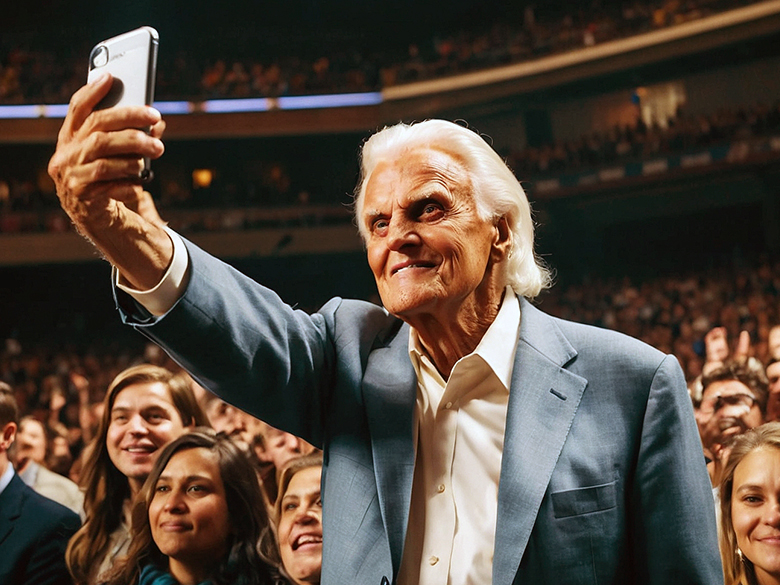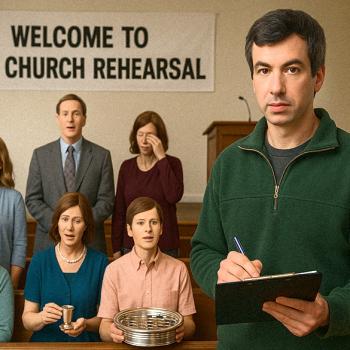
In the pantheon of American evangelists, Billy Graham stands as a colossus, his shadow looming large over the landscape of 20th-century Christianity. With a career that spanned decades and a reach that circled the globe, Graham was more than just a preacher; he was an icon, a symbol of a certain brand of faith that left an indelible mark on the fabric of American religious life. But as with all icons, the gleam of the public persona often throws the most stark and unflattering shadows. Today, we pull back the curtain on this evangelical heavyweight, not to dismiss his impact, but to dissect it, to understand how and why his version of the Gospel resonated so widely, and at what cost.
Warning: this is no reverential retrospective. We’re here to unpack, to critique, and yes, to snark. Because for all the souls he claimed to save, Billy Graham’s legacy is a complex web of influence and controversy, weaving through issues of politics, gender, morality, and money. It’s a legacy that begs for a closer, more critical look—not just to understand the man, but to grapple with the larger question of how his brand of faith shaped, and warped, the very notion of Christianity in America. So, let’s dive in, let’s dissect, and let’s discover just what Billy Graham has left us with, for better or for worse.
The Gospel of Me, Myself, and I
In the grand tapestry of Billy Graham’s evangelistic crusade, one thread stands out with peculiar prominence: his unabashed promotion of a hyper-individualistic faith. Graham’s gospel wasn’t just about saving souls; it was about saving *individual* souls, one personal prayer at a time. This wasn’t just theology; it was religious consumerism dressed in Sunday best, offering a personalized, one-on-one deal with the divine.
But let’s peel back the layers here. What does this hyper-focus on individual salvation actually mean for the broader Christian narrative, one historically steeped in community, collective responsibility, and social justice? In Graham’s world, the communal feast of faith was reduced to a microwave dinner for one. Jesus’ radical teachings about loving one’s neighbor, caring for the least among us, and challenging societal injustices were sidelined, replaced by a spiritual selfie culture that championed personal piety over communal commitment.
This shift had consequences. The emphasis on individual salvation propagated a form of spiritual solipsism, a religious echo chamber where the collective, communal aspects of faith were drowned out by the siren song of personal salvation. It’s as if Graham took the ‘body of Christ’ and turned it into a collection of disparate limbs, each vying for individual salvation like shoppers on Black Friday.
And let’s not forget the convenient byproduct of this individualistic gospel—the way it neatly sidestepped the messier, more demanding aspects of Christian teachings. Social inequality? Racial injustice? Environmental degradation? These issues require collective action, a communal faith response. But in Graham’s gospel of individualism, these pressing societal concerns were often relegated to the background, overshadowed by the paramount goal of personal salvation.
So here we stand, in the shadow of Billy Graham’s towering figure, wondering: At what cost did this gospel of individualism come? How did this singular focus on personal salvation shape the broader landscape of American Christianity, and what has been lost in the process? It’s time to ask these hard questions, to examine not just the soul of one man’s theology, but the soul of a nation that embraced it.
The “Billy Graham Rule” or How to Patronize Half the Human Race
Enter the “Billy Graham Rule,” an edict from the Modesto Manifesto that managed to turn professional interactions into a minefield of perceived impropriety. This rule, ostensibly a fortress against moral failure, dictated that men should never be alone with a woman who wasn’t their wife. Sounds noble, right? Wrong. In practice, this rule wasn’t just a protective hedge; it was a barbed wire fence, keeping women firmly outside the inner circles of power and influence.
Let’s call it what it was: a masterclass in paternalistic patronization. By wrapping misogyny in the cloak of moral piety, the Billy Graham Rule effectively sidelined women, not just socially but professionally. In the corporate corridors of churches and religious organizations, this rule didn’t just prevent impropriety; it prevented opportunity, dialogue, and advancement. Women, no matter their talent or calling, found themselves on the outside looking in, their potential stifled by a rule that branded every interaction with suspicion.
But the repercussions of this rule reverberated beyond the confines of personal interactions. It seeped into the very fabric of church leadership, effectively sanctifying a boys’ club mentality. The message was clear: men, and only men, were the keepers of moral integrity, the sole proprietors of religious authority. Women, meanwhile, were cast as either distractions or disasters waiting to happen, their potential for leadership dismissed under the guise of moral precaution.
In this one rule, Graham managed to perpetuate a system that marginalized half the human race, not just socially but spiritually. It wasn’t just about keeping men and women apart; it was about keeping power and leadership in the hands of men, relegating women to the sidelines of religious life. The Billy Graham Rule didn’t protect purity; it preserved patriarchy, cloaking it in the false virtue of moral caution.
So here we are, decades later, still grappling with the fallout of this rule, still confronting the barriers it erected. It’s high time we question the legacy of such doctrines, not just for the overt sexism they perpetuate, but for the subtle, insidious way they undermine the very principles of equality and mutual respect that should form the bedrock of any faith worth its salt.
Salvation: The Drive-Thru Experience
Billy Graham’s brand of salvation was as streamlined as it was simplistic, a spiritual fast-food chain serving up instant redemption with a side of eternal security. But in this rush to save souls en masse, what essential nutrients of the faith were lost in the process? Graham’s altar calls were like spiritual express lanes, promising a quick fix to the complex, messy human condition. Just say this prayer, sign this card, and voila! You’re heaven-bound, no further questions asked, no strings attached.
But let’s pause and ponder the depth and richness of the Christian tradition, a tapestry woven with threads of repentance, transformation, discipleship, and communal living. Against this rich backdrop, Graham’s salvation pitch starts to look less like the full banquet of faith and more like a spiritual snack, high in emotional calories but low in long-term sustenance. This reductive formula reduced Christianity’s robust call to a mere transaction, a cosmic quid pro quo that treats God’s grace like a vending machine—insert prayer, receive salvation.
This ‘drive-thru’ salvation wasn’t just theologically thin; it was spiritually shallow. It bypassed the hard work of spiritual growth, the slow, challenging process of being formed and reformed in the likeness of Christ. The Christian journey, with all its valleys and mountaintops, its deserts and oases, was flattened into a billboard promising salvation in ten words or less.
And what of the community, the body of Christ called to live out the implications of the Gospel together? In Graham’s rush to tally souls, the communal, relational aspect of faith was often left in the dust. The church, meant to be a living, breathing embodiment of Christ’s love and justice in the world, was relegated to a mere distribution center for get-out-of-hell-free cards.
In the end, Graham’s salvation superhighway left us with more than a few spiritual potholes. It’s time we reassess this fast-food faith, asking ourselves what’s lost when salvation is sold as a quick fix rather than a lifelong journey, a journey meant to be walked in the company of others, with all the messiness, complexity, and beauty that entails.
All Show, No Substance: The Graham Spectacle
If evangelism were theater, Billy Graham was its Broadway star, turning the pulpit into a stage and worship into a spectacle. His crusades were grand productions, complete with swelling music, emotional preaching, and the inevitable flood of converts streaming down the aisles. But beneath the bright lights and the orchestrated crescendos, one can’t help but wonder: where was the substance beneath the show?
Graham’s mass revivals were less about igniting lasting spiritual transformation and more about manufacturing moments of religious euphoria. Like spiritual pyrotechnics, these events dazzled the senses but left little lasting warmth. The emotional highs were pitched as spiritual breakthroughs, but how many were just adrenaline rushes, spiritual sugar highs that left a hollow emptiness once the lights dimmed and the crowds dispersed?
In this spectacle-over-substance Christianity, the quiet, daily disciplines of the faith—prayer, meditation, acts of service, communal worship—were overshadowed by the quest for the next big religious high. The showiness of the crusades, with their celebrity appeal and media fanfare, turned faith into a performance where the measure of one’s spirituality was too often equated with the intensity of one’s emotional experience.
And let’s not overlook the consumerist undercurrent of these events. The crusades were a brand, Graham was the product, and salvation was the sell. It was religion commodified, repackaged into an emotionally gratifying experience to be consumed en masse. But the hard sell of the crusade often glossed over the harder truths of the gospel—the calls to self-denial, to taking up one’s cross, to living out a faith that is as much about bearing burdens as it is about basking in blessings.
The spectacle of Graham’s crusades left an indelible mark on the landscape of American Christianity, but it’s worth asking at what cost. How much depth was sacrificed on the altar of spectacle? How many quiet, steadfast believers felt their un-dramatic faith was somehow less valid in the shadow of these religious extravaganzas? It’s time to turn down the volume, dim the lights, and look beyond the show to find the substance of a faith that’s not made for the stage, but for the soul.
Celebrities Over Deities: The Cult of Graham
In the grand theater of American Christianity, Billy Graham didn’t just play a role; he was the marquee name, the headliner whose celebrity status transcended the pulpit and permeated popular culture. But in the bright glare of the spotlight, it’s worth questioning: did the adulation for the man eclipse the reverence for the deity he preached about? Graham’s ascent to celebrity preacher was a double-edged sword, carving out a space for religion in the public square while simultaneously turning faith into a fanfare, with himself unwittingly as the main attraction.
The cult of personality that grew around Graham wasn’t just problematic for its idolatrous overtones; it shifted the focus from the teachings of Christianity to the charisma of one man. The message became inseparable from the messenger, and the messenger was, after all, only human. This celebrity-over-deity dynamic set a precarious precedent. It placed an individual on a pedestal high enough for the whole nation to see, yet dangerously wobbly when it came to the fallibility inherent in every human being.
Moreover, Graham’s stardom didn’t just influence the masses; it molded the ministry itself. The church, in many circles, began to mirror the corporate world, with a focus on branding, image, and marketability. The result? A commodified version of Christianity, where success was measured in numbers—of attendees, of converts, of dollars—and not in the intangible, transformative quality of individual souls.
But the real casualty in this culture of religious celebrity might just be the essence of the Christian faith itself: a faith that champions the meek, that preaches about a kingdom, not of this world, and that values the quiet, unseen acts of righteousness over the grand, public gestures. In the glossy pages of Graham’s celebrity preacher narrative, these humble, core tenets of Christianity were often relegated to the footnotes, overshadowed by the more glamorous, headline-grabbing elements of his ministry.
As we sift through the legacy of Billy Graham, it’s crucial to disentangle the man from the myth, the preacher from the celebrity. It’s a call to remember that, in the realm of faith, the spotlight belongs not on the stage, but on the sacred, not on the preacher, but on the teachings that transcend any one person, no matter how revered.
Civil Rights and Wrong Turns: Dodging MLK’s Calls
Billy Graham’s relationship with the Civil Rights movement was, at best, a study in cautious ambiguity, and at worst, a missed opportunity of biblical proportions. While he removed physical ropes segregating audiences and invited Martin Luther King Jr. to pray at a crusade, his steps into the waters of social justice were more a tentative toe-dipping than a committed plunge. In a time when the nation was convulsing with the pains of transformation, Graham’s voice could have been a clarion call for justice; instead, it often murmured hesitations and counsels of patience.
Let’s dissect this with the precision it deserves. Graham’s approach to civil rights was akin to applying a band-aid on a deep, festering wound. Yes, he preached to integrated congregations, and yes, he spoke out against the most overt forms of racism. But when the moment called for prophetic courage, for standing shoulder to shoulder with those fighting on the front lines for racial equality, Graham’s resolve seemed to waver. His gospel of individualism conveniently sidestepped the systemic and structural nature of racism, preferring a narrative of personal conversion over collective societal transformation.
Graham’s cautious stance was not just a personal failing; it was a theological one, reflecting a gospel sanitized of its radical, justice-seeking edge. The same gospel that inspired civil rights giants like Martin Luther King Jr. to confront oppression with the force of love and truth was muted in Graham’s ministry, its prophetic fire dampened by a focus on individual morality over systemic change.
The legacy of this equivocation is still felt today. The reluctance to engage fully with the defining social justice issue of the time contributed to a version of Christianity that too often appears complicit with the status quo, rather than a force that challenges it. Graham’s hesitancy to embrace the civil rights movement wholeheartedly not only marked a moral misstep; it symbolized a broader reluctance within segments of American Christianity to confront uncomfortable truths about race, privilege, and power.
In retrospect, Graham’s dance with civil rights is a poignant reminder of the road not taken, a call to reflect on the transformative potential of faith when it dares to step boldly into the arena of justice, equality, and radical love. It’s a call to not just admire the legacy of those like Martin Luther King Jr. but to actively embody the principles they lived and died for—a challenge that remains as pressing and as pivotal today as it was during the tumultuous days of Graham’s ministry.
A Sour Apple: The Legacy of Franklin Graham
The acorn, as they say, doesn’t fall far from the tree, but in the case of Franklin Graham, it seems the acorn took a rather unfortunate roll. As the progeny of Billy Graham, Franklin inherited not just his father’s pulpit but his platform, his audience, and, ostensibly, his mantle. However, the younger Graham has often used this inheritance as a pulpit for divisiveness, doubling down on the most controversial aspects of his father’s legacy and amplifying them with a fervor that veers into the realms of the intolerant and the incendiary.
Franklin’s brand of evangelism has been marked by a stridency that his father generally avoided, taking firm stances on hot-button issues in a manner that often seems more about drawing battle lines than extending olive branches. Where Billy’s approach was characterized by a certain calculated caution, Franklin seems to revel in the role of the firebrand, often wading into political skirmishes with a zeal that would likely have made his father balk.
This inheritance is not just a matter of shared DNA but of a shared, amplified direction for American evangelicalism, one that increasingly aligns with partisan politics and divisive rhetoric. Franklin’s leadership has seen the entrenchment of an us-versus-them mentality, a fortress mentality that views cultural engagement through the lens of combat rather than conversation. The nuanced, albeit flawed, legacy of his father has been distilled into a more polarizing brew, often alienating those who do not subscribe to the narrowest interpretations of the Christian faith.
In Franklin Graham, we see the reflections of Billy’s more contentious positions, but with the volume turned up and the subtlety stripped away. The son’s ministry raises probing questions about the trajectory of evangelicalism, about the transformation of the pulpit from a place of spiritual guidance to a platform for political grandstanding. It’s a stark reminder of the potent, sometimes perilous, influence that religious leaders wield and a call to examine the fruits of such leadership with a critical, discerning eye.
As we consider the legacy of Franklin Graham, we’re not just evaluating a single man’s ministry; we’re scrutinizing the broader implications of his influence on the shape and tone of American Christianity. It’s a narrative that prompts us to reflect on the power of religious platforms, the responsibilities of those who stand upon them, and the urgent need for a faith that unites in love rather than divides in judgment.
Financial Gospel: The Almighty Dollar Over the Almighty
In the grand narrative of Billy Graham’s ministry, there’s a subplot that often gets glossed over—the seductive dance between mammon and ministry. Graham’s evangelistic empire was not just a spiritual endeavor; it was a financial juggernaut, raking in donations from the faithful while preaching a gospel ostensibly about treasure in heaven, not on earth. This entanglement of faith and finance begs a probing question: when the collection plates pass and the bank accounts swell, where does piety end and profit begin?
While Graham himself maintained a relatively modest lifestyle, the financial workings of his organization were anything but humble. The Billy Graham Evangelistic Association, with its sprawling infrastructure and global outreach, operated more like a religious corporation than a modest ministry. Transparency, often promised, was more a buzzword than a benchmark, leaving a trail of questions about the true stewardship of the millions that poured in.
This financial opacity wasn’t just a logistical issue; it was a theological one. It muddied the waters of a faith that calls for simplicity and generosity, replacing the biblical widow’s mite with the modern megachurch’s might. In Graham’s financial gospel, the lines between ministry and market, between tithes and transactions, became blurred, casting a shadow of materialism over the message of the cross.
And what of the faithful who gave, not from their abundance, but from their scarcity, believing their offerings were sowing seeds for spiritual harvests? Their sacrifices, their acts of worship, were they merely fuel for a religious machine, one that prioritized growth and reach over humility and accountability? The commodification of faith, with salvation pitched alongside solicitations for support, presents a jarring juxtaposition—a dissonance between the humble carpenter of Nazareth and the modern machinery of evangelical enterprise.
As we scrutinize the ledger of Billy Graham’s ministry, it’s not just the numbers that demand accountability; it’s the very ethos of a faith that seems to have strayed from the narrow path of simplicity. It’s a call to reflect on the true cost of commercializing the gospel, of allowing the almighty dollar to cast its long shadow over the message of the Almighty.
Compromise in the Name of Conversion: Theology vs. Pragmatism
Billy Graham’s approach to evangelism often seemed less like a straight path and more like a winding road, marked by theological compromises in the name of broader appeal. His pragmatic approach to preaching, while undoubtedly effective in filling stadiums and swelling the ranks of the “saved,” often came at the cost of diluting the robust, challenging tenets of the Christian faith. In Graham’s gospel, the edges were softened, the demands downplayed, and the message tailored to suit the tastes of the masses, leaving us to wonder: in the quest for quantity, what quality of faith was being sacrificed?
This pragmatic gospel was a palatable one, no doubt, designed to offend none and appeal to all. But in smoothing out the rough edges of the gospel—the calls to radical discipleship, the challenging teachings on wealth, power, and self-sacrifice—Graham’s message sometimes seemed to lose its saltiness, its divine flavor that sets it apart from the wisdom of the world. The result was a faith that was easy on the ears but light on the transformation, a spiritual fast food that satiated immediate hunger but left a lingering emptiness.
But the compromises weren’t just in the message; they were in the method too. Graham’s crusades, with their spectacle and scale, mirrored the consumer culture of the time, packaging the gospel in a way that was marketable, consumable, and ultimately disposable. The altar call, a staple of his revivals, was criticized for its emphasis on the moment of decision over the process of discipleship, reducing the complex journey of faith to a single, emotion-laden moment.
The legacy of this pragmatic approach is a mixed one. On the one hand, it brought the message of Christianity to millions, making the gospel accessible in a way it had never been before. But on the other hand, it raised probing questions about the depth and durability of that message. In the delicate balance between relevance and reverence, between making the gospel understandable and keeping it uncompromised, did Graham’s ministry tilt too far towards accommodation?
As we reflect on the impact of this pragmatic gospel, we’re called to consider the costs of compromise, to ponder the line between making the gospel accessible and making it unrecognizable. It’s a call to remember that the power of the gospel lies not in its palatability but in its truth, a truth that should challenge, transform, and transcend, rather than conform to the shifting sands of cultural convenience.
Bigotry in the Name of the Bible: Antisemitism and LGBTQ+ Hostility
In the annals of Billy Graham’s legacy, there are chapters that many would prefer to keep closed. Yet, in the spirit of full disclosure, these must be brought to light, not out of malice but in pursuit of truth. Among these uncomfortable truths are Graham’s documented moments of antisemitism and his stance against the LGBTQ+ community—stances that not only mar his personal legacy but also reflect broader, more troubling undercurrents within segments of American Christianity.
The tapes don’t lie. In recorded conversations with President Nixon, Graham’s remarks about Jewish people were not just unfortunate slips but revealed a disturbing tolerance for, if not endorsement of, antisemitic stereotypes. This wasn’t merely a man of his time speaking; it was a leader whose words carried weight, shaping attitudes and potentially cementing prejudices among his vast audience. The impact of such rhetoric is hard to quantify but impossible to dismiss, contributing to a climate where bigotry could fester under the veneer of religious respectability.
Then there’s the issue of Graham’s approach to the LGBTQ+ community, an approach characterized more by condemnation than compassion. In his crusades and public statements, homosexuality was not just a sin but a sign of societal decay, a stance that alienated and ostracized, inflicting untold pain on countless individuals and further marginalizing an already vulnerable community. This rhetoric of exclusion flew in the face of the Gospel’s more inclusive, embracing ethos, casting long shadows over the church’s mission to be a beacon of love and acceptance.
The defense often mounted—that Graham was merely a product of his times—holds little water. Leadership, especially of the spiritual sort, is not about echoing the prejudices of the age but about challenging them, illuminating a path to greater understanding, compassion, and justice. In these areas, Graham’s leadership was found wanting, a painful acknowledgment for those who look up to him yet a necessary reckoning for a faith that seeks to heal, not hurt.
Reflecting on these aspects of Graham’s legacy is uncomfortable, but it’s a discomfort we must not shy away from. It’s a call to confront the darker chapters of our collective history, to learn from them, and to forge a path forward that is more inclusive, more compassionate, and more reflective of the profound, boundary-crossing love at the heart of the Christian message. It’s a reminder that bigotry, even when cloaked in religious language, is still bigotry, and that our calling is not to defend the indefensible but to strive, tirelessly, for a faith that truly embodies the love it preaches.
Muddying the Waters: Politics in the Pulpit
Billy Graham’s foray into the world of politics wasn’t just a casual side-step; it was a full-blown waltz that often blurred the lines between spiritual leadership and political endorsement. While Graham himself maintained that he was nonpartisan, his actions painted a different picture, one of a preacher deeply enmeshed in the corridors of power, frequently offering spiritual counsel to presidents and politicians alike. But in this melding of faith and politics, what was sacrificed, and what was gained?
Graham’s political engagements brought religion into the public square in a way that was unprecedented, cementing evangelicalism’s role in the national discourse. However, this influence was not without its pitfalls. The close association with power risked compromising the prophetic voice of the church, tethering it too closely to the throne of Caesar and too far from the cries of the marginalized, whom the Gospel is meant to prioritize.
This marriage of pulpit and politics also set a precedent for the evangelical community, one that has since evolved into an even more overt and contentious alliance with particular political ideologies. The fallout of this is a deeply polarized church, often more aligned with party platforms than with the radical, boundary-crossing love of Christ. In seeking to be the kingmaker, there’s a risk that the church has lost its kingdom perspective, championing policies and politicians over the principles of peace, justice, and humility.
Graham’s political legacy is a contentious one, raising questions about the role of faith leaders in the political arena. While engagement is necessary, the nature and extent of that engagement carry profound implications for the witness of the church. The challenge lies in navigating these murky waters without losing sight of the church’s primary mission—to be a beacon of hope, a voice for the voiceless, and a force for reconciliation in a fractured world.
As we reflect on Graham’s intertwining of faith and politics, it’s a stark reminder of the need for discernment and humility. It’s a call to ensure that when the church speaks, it does so not as an echo of political power but as a prophetic voice, calling all, including the powerful, to a higher standard of justice, compassion, and integrity. It’s a challenge to untangle the Gospel from partisan agendas and to live out a faith that transcends the political divides, reflecting the boundless, unpartisan love of the God it professes to follow.
Legacy Reexamined: Charting a Path Forward
In the vast, variegated tapestry of American Christianity, Billy Graham emerges as a figure of monumental significance, a man whose shadow stretches long and wide across the religious landscape. Yet, as we’ve journeyed through the contours of his legacy, we’ve encountered a narrative far more complex and contested than the polished image of the beloved preacher might suggest. From the individualistic slant of his gospel to the spectacles of his crusades, from the paternalistic undertones of the “Billy Graham Rule” to his controversial entanglement with politics, Graham’s influence was as profound as it was paradoxical.
This critical odyssey through Graham’s legacy is not a venture into character assassination but a quest for truth, an attempt to disentangle the man from the myth, the message from the messenger. It’s a reminder that history’s heroes are often flawed, their legacies a blend of light and shadow, their impact a mix of triumph and tragedy. Graham’s story is a testament to the power of faith to inspire, but also a cautionary tale of how that faith can be compromised, how the pulpit can be politicized, and how the message of love can be muddled by the messenger’s own fallibility.
As we close this chapter, let’s not shy away from the discomfort of these revelations. Instead, let’s embrace the challenges they pose and the opportunity they offer for reflection and reform. Let’s remember that the true measure of faith is not found in the size of a congregation, the charisma of a preacher, or the clamor of a crusade, but in the quiet, steady work of love—love that seeks justice, that embraces mercy, and that walks humbly. It’s a call to a faith that is not content with the status quo but is driven by a relentless pursuit of a more just, more compassionate, more equitable world.
Billy Graham’s legacy, with all its complexity and contradictions, invites us to look inward, to examine our own beliefs, our own institutions, and our own hearts. It challenges us to ask the hard questions, to confront the uncomfortable truths, and to commit ourselves anew to the essence of the Gospel—a gospel not of power, privilege, or politics, but of peace, grace, and an all-encompassing love that knows no bounds. In this, Graham’s story is not just a reflection of one man’s journey but a mirror held up to us all, a mirror in which we must discern not just the legacy of the past but the path of the future, a future we are called to shape with courage, with humility, and with an unwavering commitment to the transformative power of the Gospel.
For more Snarky Faith check out the podcast:














